 Wave Damage on inside of berm
Wave Damage on inside of berm Purdue Pork Page Archive
Lagoon Berms - Danger Signs
 Wave Damage on inside of berm
Wave Damage on inside of berm
 Seepage on outside of berm and several feet out from toe of berm
Seepage on outside of berm and several feet out from toe of berm
 Development of very damp, soft areas, slumps or bulges on outside face of berm
Development of very damp, soft areas, slumps or bulges on outside face of berm
 Rodent burrows (usually around cleaner water in second or third cell lagoon-Remove animals and backfill dens)
Rodent burrows (usually around cleaner water in second or third cell lagoon-Remove animals and backfill dens)
 Be vigilant of earthen structures - especially those that have berms elevated several feet above grade
Be vigilant of earthen structures - especially those that have berms elevated several feet above grade
Lagoon Berm Failures
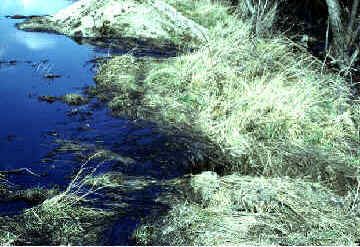
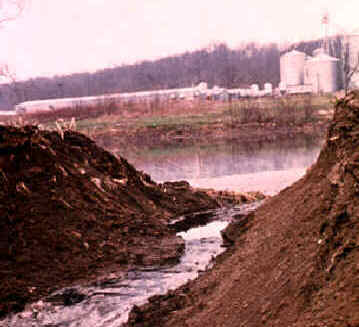
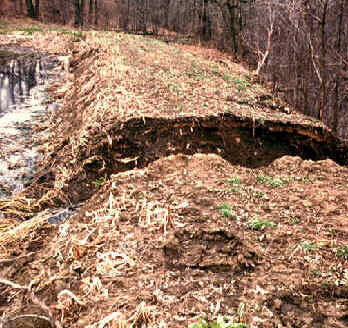
 This screen above shows the catastrophic failure of an earthen bermed lagoon. Since an earthen berm settles at different rates, some spots will always be lowers than others. Any lagoon overflow will find these low spots and through erosion will create an ever wider and deeper opening, eventually causing failure of the berm.
This screen above shows the catastrophic failure of an earthen bermed lagoon. Since an earthen berm settles at different rates, some spots will always be lowers than others. Any lagoon overflow will find these low spots and through erosion will create an ever wider and deeper opening, eventually causing failure of the berm.
 An emergency spillway, if allowed in your state, should always be used if at least one side of the lagoon is at grade. Install a well-sodded waterway 1:5 slope or less near the grade level side of the lagoon to divert excess water rather than allowing the berm to overtop. Set the emergency spillway at 6" below the level of the berm. Certainly any lagoon overflow should be avoided if at all possible, but a small trickle of overflow is certainly preferable to total failure, and can be corrected with considerably less damage to the environment. If the all sides of the lagoon are above grade, an earthen emergence spillway will not be feasible. Consider instead a large metal or plastic pipe overflow that discharges in an area that is readily observable by the operator.
An emergency spillway, if allowed in your state, should always be used if at least one side of the lagoon is at grade. Install a well-sodded waterway 1:5 slope or less near the grade level side of the lagoon to divert excess water rather than allowing the berm to overtop. Set the emergency spillway at 6" below the level of the berm. Certainly any lagoon overflow should be avoided if at all possible, but a small trickle of overflow is certainly preferable to total failure, and can be corrected with considerably less damage to the environment. If the all sides of the lagoon are above grade, an earthen emergence spillway will not be feasible. Consider instead a large metal or plastic pipe overflow that discharges in an area that is readily observable by the operator.
Lagoon Berms - Protecting Against Failure
 Thoroughly inspect berm every month or after large rainfall
Thoroughly inspect berm every month or after large rainfall
 Look for low or bare spots, start of rills or gullies on berms - if found, fill with soil, compact, reseed, mulch with straw. Irrigate if necessary for good stand
Look for low or bare spots, start of rills or gullies on berms - if found, fill with soil, compact, reseed, mulch with straw. Irrigate if necessary for good stand
 Keep grass on berm and emergency spillway mowed and fertilized to create thick sod and make inspection easier
Keep grass on berm and emergency spillway mowed and fertilized to create thick sod and make inspection easier
 Monthly inspection of lagoons berms by a knowledgeable person is advisable. Even more frequent inspection is recommended in some states.
Monthly inspection of lagoons berms by a knowledgeable person is advisable. Even more frequent inspection is recommended in some states.
 Keep earthen berms and the area around a lagoon well-trimmed facilitate inspections and to make the area less inviting to burrowing rodents.
Keep earthen berms and the area around a lagoon well-trimmed facilitate inspections and to make the area less inviting to burrowing rodents.
 Prevent growth of trees and bushes because root system can lead to seepage and shelter burrowing animals
Prevent growth of trees and bushes because root system can lead to seepage and shelter burrowing animals
 Replace all moved, settled or destroyed slope protection such as riprap or concrete paving
Replace all moved, settled or destroyed slope protection such as riprap or concrete paving
 Maintain fence and warning signs
Maintain fence and warning signs
 Consult a Registered Engineer, local NRCS or the state natural resources office for assistance if needed
Consult a Registered Engineer, local NRCS or the state natural resources office for assistance if needed
 Be especially careful in "raising" the height of
earthen berms to increase the capacity of the storage. A knowledgeable engineer
and contractor are needed to ensure that the added fill height is properly
compacted and keyed into the existing berm to create a sound structure and
prevent a potentially dangerous situation.
Be especially careful in "raising" the height of
earthen berms to increase the capacity of the storage. A knowledgeable engineer
and contractor are needed to ensure that the added fill height is properly
compacted and keyed into the existing berm to create a sound structure and
prevent a potentially dangerous situation.
 Each state should have state-level expertise in earthen water storages and earthen dam inspection. Often, NRCS can offer engineering assistance and state land-grant universities may have extension publications that will be useful in maintaining a safe lagoon system.
Each state should have state-level expertise in earthen water storages and earthen dam inspection. Often, NRCS can offer engineering assistance and state land-grant universities may have extension publications that will be useful in maintaining a safe lagoon system.
Lagoon Berm Inspection
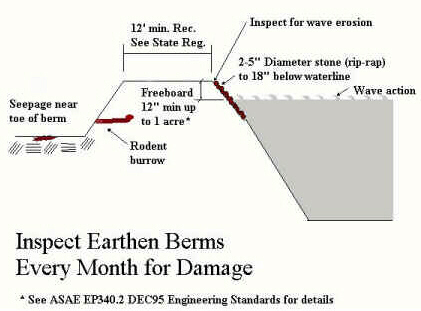
 This sketch shows some of the things to look for when inspecting an earthen lagoon.
This sketch shows some of the things to look for when inspecting an earthen lagoon.
Lagoon Berm Design
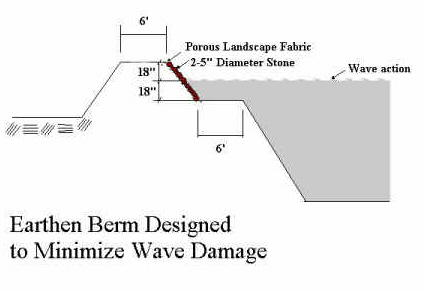
 This is an innovative method of lagoon construction, designed to lessen the effect of wave action on an earthen berm. This is becoming a more serious consideration as lagoons become larger, and as lagoon surfaces are often elevated 10-15' above grade where wind speed is greater.
This is an innovative method of lagoon construction, designed to lessen the effect of wave action on an earthen berm. This is becoming a more serious consideration as lagoons become larger, and as lagoon surfaces are often elevated 10-15' above grade where wind speed is greater.
Purdue Pork Page Archive